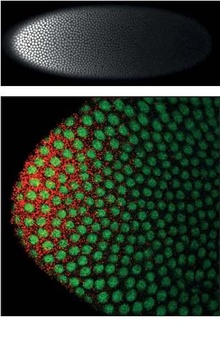Homeotic protein bicoid
| Homeotic protein bicoid | |||||||
|---|---|---|---|---|---|---|---|
| Identifiers | |||||||
| Organism | |||||||
| Symbol | bcd | ||||||
UniProt | P09081 | ||||||
| |||||||

Homeotic protein bicoid is encoded by the bcd
Role in axial patterning
Bicoid mRNA is actively localized to the anterior of the fruit fly egg during oogenesis
Structure and function

Bicoid is one of the few proteins which uses its homeodomain to bind both DNA and RNA targets to regulate their transcription and translation, respectively. The nucleic acid-binding homeodomain of Bicoid has been solved by NMR.[15] Bicoid contains an arginine-rich motif (part of the helix shown axially in this image) that is similar to the one found in the HIV protein REV and is essential for its nucleic acid binding.[16]

Bicoid protein gradient formation is one of the earliest steps in fruit fly embryo A-P patterning. The proper spatial expression of downstream genes relies on the robustness of this gradient to common variations between embryos, including in the number of maternally-deposited bicoid mRNAs and in egg size. Comparative phylogenetic[17] and experimental evolution[18] studies suggest an inherent mechanism for robust generation of a scaled Bicoid protein gradient. Mechanisms that have been proposed to effect this scaling include non-linear degradation of Bicoid,[19] nuclear retention as a size-dependent regulator of Bicoid protein's effective diffusion coefficient,[10][20] and scaling of cytoplasmic streaming.[10]
See also
References
- PMID 21390295.
- ^ S2CID 18830552.
- PMID 18328473.
- PMID 19020592.
- S2CID 4406927.
- PMID 2483989.
- PMID 1684934.
- PMID 16890164.
- PMID 18639459.
- ^ PMID 19190186.
- PMID 17632061.
- S2CID 9658875.
- PMID 19168676.
- PMID 25390693.
- PMID 16406070.
- PMID 10882080.
- PMID 18328473.
- PMID 24284208.
- PMID 14536064.
- PMID 20699297.
